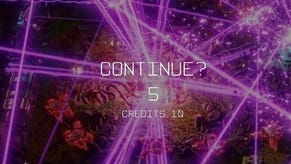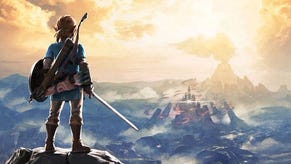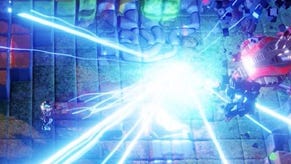Nex Machina review
Robotron 2017.
Good arcade designers often work with four words buzzing around in their brains: What Would Jarvis Do? Jarvis - and I hope I don't need to explain this - refers to Eugene Jarvis, and he's amongst the greatest twitch game designers of all time. With Defender, he created a coin-op legend, a game so overwhelming in its flair and complexity and sheer visual impact that people would drop money into its innards just to witness the explosion that erupted when they died. With Robotron, a broken hand lead to the creation of the first properly implemented twin-stick shooter system in games - you move with one joystick and aim with the other. No fire button needed, because Robotron was relentless.
It was, and is, a beast. You spawn in the centre of the screen to find enemies all about you. These enemies have different behaviours: some are coming for you, some are bad news for the humans scattered around that provide the game's only collectable. Some are firing bullets, and some barely know that you are there. In the primordial soup of all this gloriously simple AI, magical emergent behaviour swarms and multiplies: grunts cluster in bait balls as they pursue you, enforcers work their ways into the corners of the screen. God, it is a hell of a thing. Smash TV coming years later picked up key threads while splitting the action across interlinked rooms, even chucking in a few bosses. A gloriously 80s plot had you fighting not for the last vestiges of humanity but for toaster ovens and other game show glories. Miyamoto might be gaming's Spielberg, but Jarvis is our John Carpenter: violent and angry and funny and oddly elegant all at once. He is well-deployed randomness. He is almost too much.
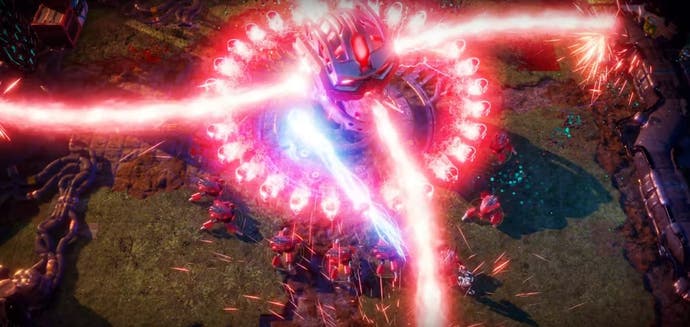
Deep breath. All of which makes Nex Machina, the fruits of a partnership between Jarvis and Finnish Jarvis acolytes Housemarque, such a treat. I have no idea how deep the relationship went - Jarvis is listed as "creative consultant" - but as I play, part of the fun of this is trying to spot the point at which one arcade great influences the other.
It helps that, while it shares preoccupations with Jarvis's early classics, Housemarque is actually a very different developer. Resogun will work as an example. It's Defender, in that you dash back and forth along a scrolling screen, shooting aliens to pieces and rescuing defenceless humans scattered around the place. But it's also absolutely not Defender, because the AI-driven unpredictability of Defender's enemy waves has been replaced here by some of the greatest choreography in modern games. Resogun looks like chaos when the screen is filled with bullet hell, but deep down this is actually bullet heck, and if you're playing it right you're hitting your marks like a stuntman during a sinuously long take in a John Woo movie. Spawn here, turn right immediately, shoot these guys, turn left, shoot those guys. Up, dash, through those guys and then let everything go all at once. Magic, but a very different kind of magic.
Nex Machina? Nex Machina is both kinds of magic. It's a twin-stick shooter with humans to collect like Robotron, it's spread across interlinked rooms like Smash TV, albeit interlinked rooms that are Mobius-stripped over the surprisingly complex surfaces of stages that must look like chunky, multi-faceted pieces of modern corporate sculpture. It has bosses like Smash TV. But it is made of voxels, like Resogun, which means enemies explode in showers of breakfast cereal. It has power-ups that come with the power-up lady voice plucked out of all the best Housemarque games (calm and somehow defiant, she is probably my favourite character in modern gaming). It has a dash that is crucial for finding elbow room and navigating laser beams. It even has those enemies that pop up riding along spectral tramlines like in Resogun, who turn up at set intervals and must be blasted to pieces before they disappear off screen.
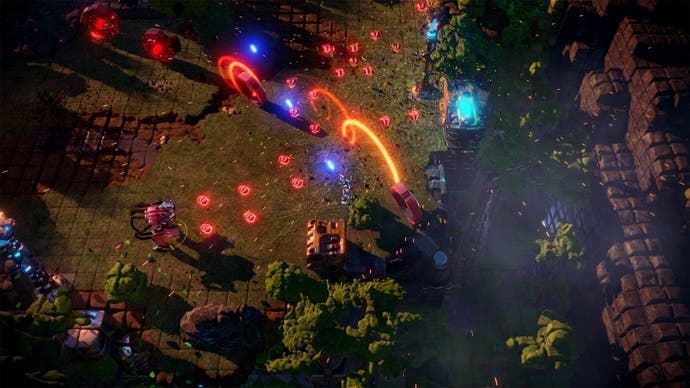
And so at the centre of Nex Machina is this glorious contradiction: a game in which there is real stage-management as you move from one arena to the next, but which still has room to surprise you. From Housemarque you get the spectacle of beautifully planned enemy waves threading together, but from Jarvis, you get the sheer relentlessness that comes from enemies waddling in en masse and announcing, as they race for you, that they have not bothered to read the script. This game feels less like a collaboration and more like a huge, beautiful, precision machine, with a very special ghost rattling around inside. Jarvis!
Enemy design is a high point, hulking, rattling robot jerks of all shapes and sizes, wriggling with cables and picked out in villainous red highlights. Grunts swarm in, but there are big guys who head for the humans, and there are clever spins on everything from snipers to bombers, and one particularly awful monster who unleashes an expanding laser boundary after you've killed him. Bosses punctuate things beautifully, multi-wave set-pieces who clomp in trailing names like Yeti Kong, who even manages to crowbar in a sly joke about Mario before he does you in.
Special weapons and power-ups round out the moment-to-moment to play. Power-ups offer twists like an explosive dash or a better weapon spread; weapons provide quick-recharge delights like a rocket launcher and a sword. A sword in a Robotron game! It is almost too much to take in.
The levels themselves bring everything together, elbowy interconnected spaces that echo with secret areas, secret humans to collect, secret beacons to find and shoot, and plenty of other doodads to hunt down. They have their own rhythms as you zoom between one arena and the next, and they have their own feel, from moments where you're navigating lava in destructible voxel caves to set-pieces in which you battle snipers and drop ships as they congregate on Blade Runner roof tops. The campaign is a brisk six worlds, but it's not about getting to the end, it's about getting to the end with an astonishing score, combos undamaged by accidental deaths, no enemies missed, no humans uncollected. Everything in Nex Machina is an opportunity - an opportunity to excel or to create a mini-disaster. Those humans are always tempting you into trouble; those Visitors riding their rails are always making you curse the fact that you've arrived in the right place at just the wrong time.
Outside of the campaign, there's solo level play, and an Arena mode that sees you unlocking weird new variants that send you back into familiar territory with an unusual agenda: make it through extra fast, or without collecting any humans at all, say. There's also a selection of bizarro challenges to notch up. Beat five levels without moving. Is that even possible? (It is.)
Throw in local co-op and the sheer voxel-strewn beauty of it all, and 2017 is looking pretty good. Marvellous, even. Follow me on this one: Nex Machina feels like less like a game and more like the happy, diabolical result of a seance. One night, in the dark of a Finnish winter, Housemarque summoned the devil. And the devil was Eugene Jarvis.





